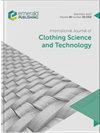菌丝体作为可持续纺织材料的研究进展及展望
IF 1
4区 工程技术
Q3 MATERIALS SCIENCE, TEXTILES
International Journal of Clothing Science and Technology
Pub Date : 2023-04-27
DOI:10.1108/ijcst-01-2022-0003
引用次数: 1
摘要
菌丝体是一种即将出现的生物基替代材料,在不同的工业中有着广泛的应用。菌丝体材料被用作复合材料、皮革、建筑材料等,有些甚至可用于商业用途。然而,当涉及到菌丝体作为纺织品替代品的应用时,没有太多的研究发现。本文的目的是探讨菌丝体在纺织工业中的潜力及其可能的应用。设计/方法/途径本综述整合了两种主要用于真菌菌丝体生产的方法,即;作为复合材料和纯自生菌丝片。本研究比较了各自领域的研究现状,并报道了纯菌丝体发育的范围。结果在不同原料的复合生产中进行了一些研究工作。生产方法和产品开发步骤已经很好地建立了从家庭公用事业到建筑材料的几种应用。而在自生菌丝片生产方面,仅有有限的研究工作。虽然工程复合材料片材的各种性能得到了发展,但对自生长纯菌丝体片材的研究还处于初级阶段。敏感的生产方法、较低的拉伸、撕裂、较差的处理性能、脆性结构和厚度不均匀性是局限性。具有可持续性的、自生长的具有多孔结构的三维纳米纤维网络具有优势。固体培养法被认为是培养不同尺寸片状自生菌丝体的一种有潜力的方法。综述结果清楚地表明,在自生纯菌丝体的直接应用领域,在原料、真菌种类的选择和所开发产品的表征等方面的研究还很缺乏。解决现有的限制,将产生具有巨大潜力的时尚和纺织工业的可持续纺织材料。本文章由计算机程序翻译,如有差异,请以英文原文为准。
Mycelium as sustainable textile material – review on recent research and future prospective
PurposeMycelium is an upcoming bio-based alternative material that has various applications in different industries. Mycelium materials used as composites, leather, construction materials and some are even available for commercial purposes. However, there was not much research found when it came to the application of mycelium as a textile alternative. The purpose of this paper is to examine the potential of mycelium in the textile industry and its possible applications.Design/methodology/approachThis review consolidates literature that refers the two major methods used in fungal mycelium production namely; as a composite and as a pure self-grown mycelium sheet. The study compared the current research status in this respective field and reported the scope in the pure mycelium development.FindingsThe results of the review reported that several research works are performed in composite production with different feedstock. The production methods and product development steps were well established for several applications from home utilities to construction materials. Whereas, in the case of self-grown mycelium sheet production only limited research works were found. Though the possibilities of engineered composite sheets are developed with various properties, research on self-grown pure mycelium sheets are at infant stage. Sensitive production methods, lower tensile, tearing, poor handle properties with brittle structure and non-uniformity in thickness are noted as limitations. Sustainable nature, self-grown three-dimensional nano-fibril network with porous structure are found to be advantageous.Originality/valueThe solid culture method was identified as a potential method to develop a sheet-like self-grown mycelium with different dimensions. The review results clearly show the lack of research in the direct application of self-grown pure mycelium area concerning feedstock material, fungal species selection and characterization of the developed product. Addressing the existing limitations will yield a sustainable textile material for fashion and textile industry with great potential.
求助全文
通过发布文献求助,成功后即可免费获取论文全文。
去求助
来源期刊
CiteScore
2.40
自引率
8.30%
发文量
51
审稿时长
10 months
期刊介绍:
Addresses all aspects of the science and technology of clothing-objective measurement techniques, control of fibre and fabric, CAD systems, product testing, sewing, weaving and knitting, inspection systems, drape and finishing, etc. Academic and industrial research findings are published after a stringent review has taken place.

 求助内容:
求助内容: 应助结果提醒方式:
应助结果提醒方式:


